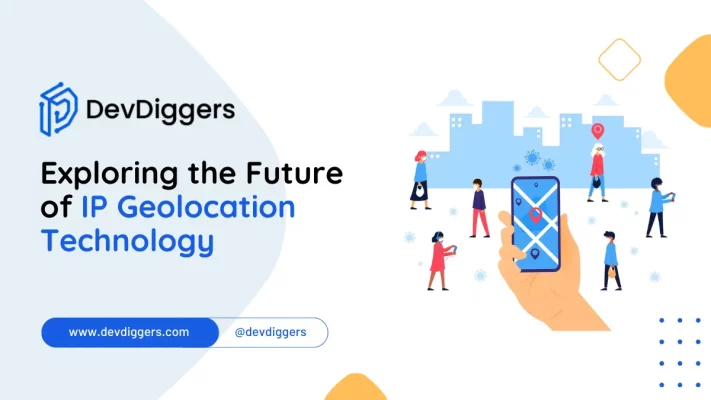Exploring the Future of IP Geolocation Technology

In a time of prevalent internet connections, technology’s influence on our online experiences is always improving.
IP Geolocation, which uses an IP address to establish a customer’s position, has become an essential resource in various areas, including Marketing and Cybersecurity.
The trend of IP Geolocation Technology indicates exciting advancements and a wide variety of possibilities as we move forward.
Table of Contents
Comprehending the Fundamentals
Before moving on, let us first understand the fundamentals of IP Geolocation. Each online device is given an IP (Internet Protocol) address.
IP Geolocation uses this address to pinpoint a device’s position, providing important details about its users’ locations.
For those interested in exploring their IP address and geolocation, applications like IP Location provide valuable insights.
Nowadays, IP Geolocation has several uses, from avoiding scams and cybercrime to precise advertising and content adaptation.
As we look into the future, many possible improvements and advanced uses of this technology become more apparent.
The Uses of IP Geolocation Technology

IP geolocation technology is currently utilized for various purposes in several sectors and is deeply embedded in many facets of our digital life. Let’s examine a few contemporary uses of it and how they affect our day-to-day interactions:
1. Using Geolocation Data for Predictive Analytics and Behaviour Modelling
- Geolocation information is used by statistical analysis to improve client service and shopping experiences.
- Personalized suggestions are generated by examining a user’s historical behaviour and present location.
- Customer service can provide proactive assistance based on the client’s location and previous encounters.
- Because of customized advertising, users are guaranteed to be shown pertinent material while going about their daily lives.
2. Enhanced Safety Standards Using Verification Methods Based on Geolocation
- Geolocation-based verification techniques, which demand physical presence in designated areas for multi-factor authorization, strengthen safety measures.
- Only authorized devices are allowed inside virtual borders when geo-fencing limits access to critical regions.
- Fraud detection systems examine unusual location-based behaviour to stop doubtful financial transactions.
- These techniques provide both physical presence and proof of identity for safe access.
3. Use of Geolocation in Up-and-Coming Technologies: Smart Cities and Augmented Reality
- Augmented reality improves sightseeing and educational opportunities by superimposing historical data on actual sites.
- Real-time location data helps smart cities manage traffic more efficiently, which lowers jams and boosts productivity.
- With the help of self-driving technology, autonomous cars are revolutionizing transportation by relying on exact geolocation for secure travel.
Evolving IP Geolocation Technology for the Future

Within the dynamic field of technological inventiveness, IP Geolocation tech is at the forefront of revolutionary advancements.
Modern innovations will transform our understanding of and utilization of location-based data as we traverse the future.
Let’s examine the key aspects of this technological progress.
1. Increased Integration with IoT Devices
The Internet of Things, or IoT, is a quickly growing network of linked devices that exchange information and interact. IP Geolocation technology’s future is inextricably linked to the Internet of Things.
As more devices interact, from automated household items to wearable devices, the demand for accurate location information increases.
IP Geolocation will play an important role in optimizing the operation of IoT devices based on users’ locations. For example, fitness trackers may propose exercises depending on where a person is, and smart thermostats can modify the temperature based on regional weather conditions.
These apps provide new opportunities for modified services and improve consumer interaction.
2. Utilizing Geofencing to Strengthen Security Protocols
Future IP Geolocation Technology is expected to witness significant expansion in Geofencing, creating virtual borders linked to specific geographical areas.
Geofencing can completely transform security protocols. Consider a situation where a bank uses geofencing to identify and stop unauthorized transactions.
A warning is issued if a Credit Card is utilized outside the consumer’s usual geographic areas, which may prevent unauthorized access. This preventive strategy for safety is in line with the growing demand for strong safeguards in the digital age.
3. The Development of Hyperlocal Marketing Techniques
Marketing methods are constantly developing to meet the expectations of a digital world that is becoming increasingly productive.
IP Geolocation infrastructure will lead to the growth of hyperlocal marketing when companies target their advertising to prospective consumers’ nearby areas.
Hyperlocal marketing aims to give highly focused information to people within a certain geographic distance, usually within a few miles of a company site.
Using IP geolocation technology, companies may effectively modify advertising messages to local customers’ distinct requirements and preferences using GPS-based data.
For instance, a coffee shop may utilize hyperlocal marketing to invite people in the area to visit the shop for a cheap cup by offering a limited-time deal. In the same way, a retail shop may emphasize special in-store events or deals in particular advertisements that it sends to consumers nearby.
Hyperlocal marketing reduces irrelevant material and enhances user engagement by providing content modified to the local context.
Focusing on specific customers boosts conversion rates and strengthens relationships between small companies and their clientele.
Difficulties with Privacy and Ethical Issues
The development of IP Geolocation innovation raises many ethical issues, especially consumer confidentiality.
Businesses and service suppliers must struggle between protecting client confidentiality and using location data to develop better services.
More stringent regulations and improved privacy protections will be necessary in the future. The risk of exploitation increases with the complexity of IP Geolocation.
Stakeholders must prioritize clear policies that notify consumers about acquiring and utilizing their location information.
Challenges and Future Improvements
Even though IP Geolocation has advanced significantly, challenges still exist. IP-based Geolocation systems usually provide an accuracy of 55 to 80% when locating a user’s state or region and between 50 to 75% when locating a user’s city.
However, it is important to remember that the precise accuracy could change according to the service provider and the device’s location.
Additionally, accurate locations can be obscured by elements like proxy servers and Virtual Private Networks (VPNs), which might result in errors.
A multifaceted strategy will be needed to overcome these obstacles in the future. Integrating real-time data sources and developing Machine Learning Algorithms may lead to more precise geolocation findings.
Enhanced cooperation among relevant parties, such as ISPs and IT firms, can also aid in developing and expanding the databases used to map IP addresses.
In Summary
IP Geolocation innovation has a bright future ahead of it. The world of computerized contacts will change significantly due to the incorporation of machine-learning techniques, the growth of IoT devices, and the emergence of hyperlocal marketing.
However, as we move through this future, privacy and ethical issues must be at the forefront of technology development.
